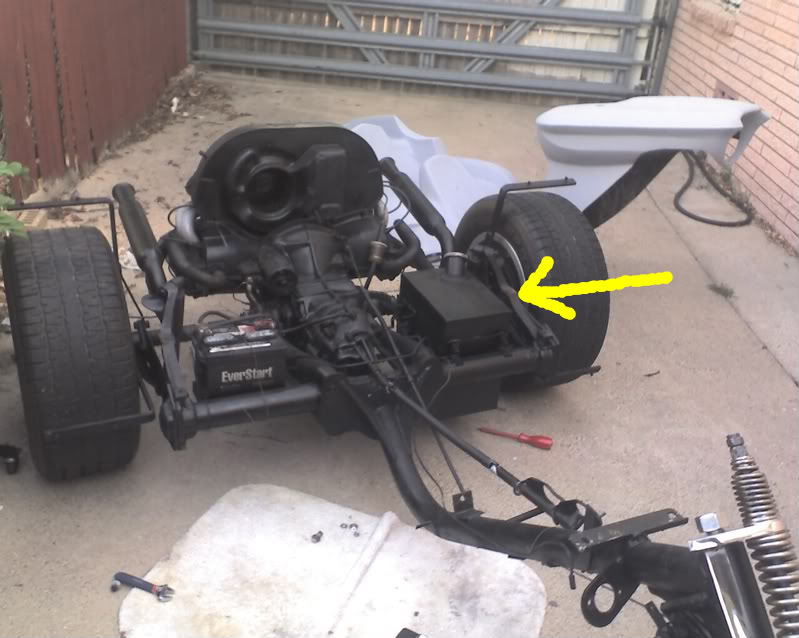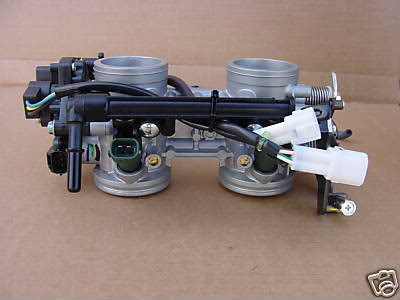Monday evening, I picked up a warranty replacement starter with no quibbles and installed it with no difficulties. So far, so good. It has not yet failed to crank, though it’s only been used a couple dozen times thus far.
I am not an expert, but I think I have done enough reading and comprehension at this point to understand ignition advance better than I ever have before, even through the EFI conversion on Buzz.
In the extreme short version, the spark needs to happen at the right time based on a large number of engine operating factors. With some engine applications, a lot of these factors can be ignored, or maybe more accurately, considered to be static. It’s the changing parameters that make good ignition hard to do.
The biggest factors are engine load, meaning the work that the engine is *expected* to do at any given instant, and RPM. How the ignition system needs to respond to these two factors is somewhat affected by engine and air temperature, compression ratio, fuel quality, combustion chamber geometry, ignition spark energy, even intake tract length and probably a thousand other little factors, many of which can be taken as constants in any given engine. For example, your compression ratio is not expected to change during normal engine operation.
The reason the ignition timing has to change is because the burning fuel mixture contained within the cylinders tends to burn at about the same speed regardless of the engine’s RPM. In order to extract power efficiently, the spark has to be timed such that the fuel burns and produces peak pressure just as the piston begins to travel downward on the power stroke, just after TDC (Top Dead Center, which might be a good name for a band). If the spark is too soon, pressures build dangerously fast and you get knocking, overheating, melted pistons, etc. If it’s too late, you miss out on much of the available power and greatly increase the amount of unburned fuel that goes out the exhaust.
Timing is expressed in degrees relative to TDC. Because of the nature of the engine and the time it takes for the fuel to burn, timing adjustments are almost universally towards the advance, so that the spark occurs before TDC. If either the load (throttle opening, really) or RPM or both go up, the spark needs to happen earlier so that the burning fuel can catch up with the moving pistons.
With an old school ignition system with mechanical points and distributor, this advance is generally introduced by moving the points in a limited arc around the distributor shaft. This is usually done with a piston or diaphragm connected to a vacuum source (not just any vacuum source will do; see below), centrifugally with weights and springs that respond to the distributor RPM or some combination of the two.
The ubiquitous Bosch ‘009’ distributor, an extremely popular replacement unit on VW engines, uses the centrifugal method and thus responds only to engine RPM. The weights and springs combine to provide an advance curve that generally runs from about 5 to 30 degrees. The weights and springs can be changed out to tune the curve and the maximum advance somewhat, but generally, you set the distributor to the maximum advance appropriate for your engine, usually around 30 degrees, and the rest of the advance curve lands where it lands. With some carburetor combinations, this results in a notorious “flat spot” off idle. The driver opens the throttle needing more power, and the small amount of advance provided at low RPM isn’t enough to to make the engine respond quickly. Since the fuel delivered by a carburetor is very dependent on the volume of air flowing through it, the open throttle combined with the as yet low air flow though the carburetor makes the mixture rather lean and the engine stumbles. The resulting “flat spot” can range from minor annoyance to deathtrap, depending on severity. Proper setting of the accelerator pump, which squirts a bit of extra fuel down the carburetor throat based on the rate the throttle is opening, can go a long way towards compensating for much of the flat spot, though it really just masks the actual problem, too little ignition advance.
A distributor equipped with a vacuum advance system can be much more responsive to engine load. This vacuum signal is provided from small holes placed very carefully at specific places in the carburetor throat. Generally, they are placed very near the throttle butterfly, usually just above it. By placing it so, when the throttle is closed, there is little or so vacuum on the advance mechanism, so no little or ignition advance. When the throttle is opened, especially at a moderate to high opening rate, a relatively strong vacuum is presented to the advance and the engine responds much quicker to the open throttle.
There are distributors that combine vacuum and centrifugal in one unit, allowing the engine to respond quickly to throttle changes, but letting engine RPM dictate the total advance.
With the yellow trike, the flat spot was about the middle of the range, more frustrating that anything else. It was pretty easy to kill the engine, especially when the new foot controls were just installed and nobody was used to them yet. It was also pretty easy to get unintended (and generally unwelcome) wheelies, especially if trying to make some quick maneuver such as a U-turn, as I tended to rev the engine pretty high to avoid killing it and would end uppartly dumping the clutch while wrenching away on the bars, working the throttle, holding your feet up on the clutch and brake, etc.
As mentioned in a previous post, I got a vacuum advance distributor (which may be vacuum and centrifugal; there was no documentation provided and I have not had cause to disassembled it enough to see) in an attempt to tame the flat spot. At first, it did not seem to make a bit of difference in how the engine ran. This made me crank up the research as to why. The most important point I discovered (and this should be intuitive) is that not all vacuum distributor designs respond the same to the vacuum and not all carburetors provide the same vacuum signal.
I picked up a vacuum gauge and kind of plotted the vacuum signals from each of the ports on the Brosol H30/31 carburetor and the response of the generic distributor to an applied vacuum.
On the distributor, I used a handy vacuum pump that I had hanging around (my mouth) and watched the gauge and the advance plate while applying various degrees of vacuum. The plate begins to move at 4-5 in Hg and has moved through it’s range by about 15 in Hg. As verified later with a timing light, this plate movement represents about 30 of degrees advance adjustment.
I checked all 4 vacuum ports on the carburetor. Here is a pic of someone elses (dirty) H30/31 carb with the ports marked with the results of my testing. I simply didn’t have a suitable pic of my own.
The port on the left side of the carb, the one that normally connects to the vacuum advance, provides a signal that responds appropriately to the throttle, but is nowhere near strong enough to move the mechanism on the distributor. The next one had a very strong signal with the throttle closed and dropped with throttle opening, pretty much the opposite of what we need. The third port had no measurable vacuum at all. Finally, the fourth port, the original purpose for which I cannot venture more than a guess, provides a strong enough signal.
With idle timing set at 7-10 degrees BTDC, the engine revs much better and the distributor provides advance to about 40 degrees when reving. The engine definitely worked better but the flat spot was only reduced, not eliminated.
I observed the operation of the accelerator pump and concluded that it was probably set too light. I tried for a bit to get to the adjusting nut, but where it is placed, it was fairly easy to see and nearly impossible to touch, especially with enough force to adjust it. While it’s not conducive to tuning and tweaking, I decide that I would need to remove the carburetor to adjust the accelerator pump, so I set about that simple task. The gasket would need replacing, which would involve a trip to the parts store, but this thing needed adjusting. I’m glad I removed the carburetor because it revealed what I think was probably the single biggest contributor to a host of problems.
The throttle was very stiff, stiff enough that my forearm and hand ached from the road trip last weekend. The throttle did not return to closed very well, either. This helped obscure the flat spot issue to a large degree by keeping the revs up, but when I tweaked with the throttle return spring and was able to get it to return better, the cost was an even stiffer throttle.
Well, once the carb was off the engine and I was trying to adjust the accelerator pump, it became apparent that the accelerator pump linkage was the source of this stiffness. It required substantial effort to push the pump lever and it dragged down the spring’s attempt to close the throttle.
I carefully removed the pump diaphragm from the carburetor and found that the pump arm did not move freely. I drove the pin out and discovered where the problems were. I bent the top arm a bit, reamed the pivot holes open a bit, filed the flat part of the pivot a little thinner then reassembled and oiled it. It now moves very freely. I also maximized the pump stroke to deliver a bigger shot of fuel. I also installed another spring that I had for throttle return, though I need to experiment to see if it’s really any lighter than the stock spring.
The result was just short of magical. Throttle effort is reduced to maybe a little stiffer than a motorcycle. Reving at a halt is quick and has a very strong, hot roddy sound. If you REALLY try, you can just detect a tiny stumble if you are rolling at idle and slam the throttle open. You have to try carefully because doing that behavior will definitely get you a little bit of front wheel air, about 2″ up for a couple of feet if my estimate is good.
I rode up and down the street quite a bit, hard and fast, light and easy and I could not trip it up.
The extra throttle response definitely highlights that the front transaxle mount has got to go. The nose cone clanks against the frame member underneath it. That will definitely lead to Bad Things ™ if allowed to continue. Likewise, the headlight really needs to be mounted better and higher because the fender hits it when you brake hard and the chassis pitches forward a bit and especially when you land hard from the high wheelies which are easier and more controllable now. [did I write that out loud?]
Tonight, I hope to work on getting the VDO speedometer working electrically, which will involve running a wire from the front to the rear. I think I may add some wire from the fuse panel to offload some of the draw on the main ignition switch fuse and add a starter relay. I have blown that fuse a few times with the starter solenoid. I am expecting a mounting cup for the speedometer to be delivered tomorrow, so getting the wiring done tonight would be great.



